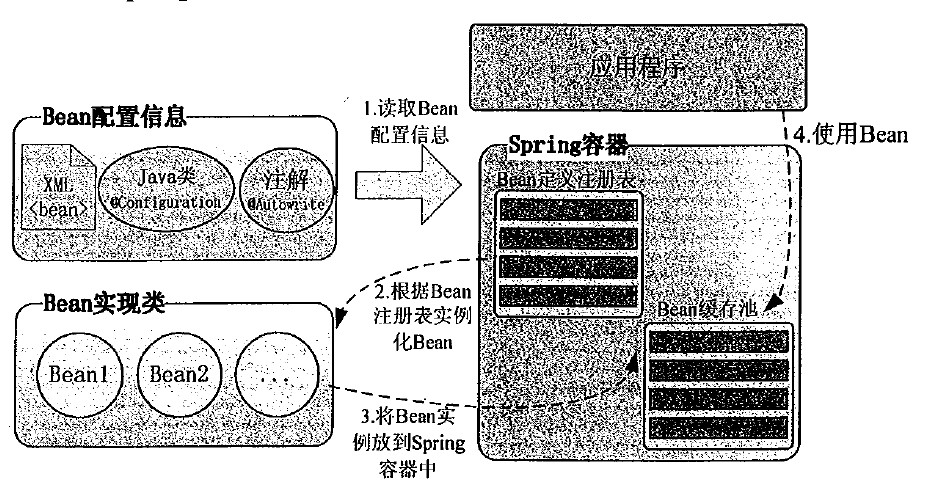标签:例子 item 输出 [] 描述 work 说明 默认值 oba
被称作 bean 的对象是构成应用程序的支柱也是由 Spring IoC 容器管理的。bean 是一个被实例化,组装,并通过 Spring IoC 容器所管理的对象。这些 bean 是由用容器提供的配置元数据创建的,例如,已经在先前章节看到的,在 XML 的表单中的 定义。
bean 定义包含称为配置元数据的信息,下述容器也需要知道配置元数据:
如何创建一个 bean
bean 的生命周期的详细信息
上述所有的配置元数据转换成一组构成每个 bean 定义的下列属性。
| 属性 | 描述 |
|---|---|
| class | 这个属性是强制性的,并且指定用来创建 bean 的 bean 类。 |
| name | 这个属性指定唯一的 bean 标识符。在基于 XML 的配置元数据中,你可以使用 ID 和/或 name 属性来指定 bean 标识符。 |
| scope | 这个属性指定由特定的 bean 定义创建的对象的作用域,它将会在 bean 作用域的章节中进行讨论。 |
| constructor-arg | 它是用来注入依赖关系的,并会在接下来的章节中进行讨论。 |
| properties | 它是用来注入依赖关系的,并会在接下来的章节中进行讨论。 |
| autowiring mode | 它是用来注入依赖关系的,并会在接下来的章节中进行讨论。 |
| lazy-initialization mode | 延迟初始化的 bean 告诉 IoC 容器在它第一次被请求时,而不是在启动时去创建一个 bean 实例。 |
| initialization 方法 | 在 bean 的所有必需的属性被容器设置之后,调用回调方法。它将会在 bean 的生命周期章节中进行讨论。 |
| destruction 方法 | 当包含该 bean 的容器被销毁时,使用回调方法。它将会在 bean 的生命周期章节中进行讨论。 |
Bean 与 Spring 容器的关系
下图表达了Bean 与 Spring 容器之间的关系:

Spring IoC 容器完全由实际编写的配置元数据的格式解耦。有下面三个重要的方法把配置元数据提供给 Spring 容器:
基于 XML 的配置文件
基于注解的配置
提示:对于基于 XML 的配置,Spring 2.0 以后使用 Schema 的格式,使得不同类型的配置拥有了自己的命名空间,是配置文件更具扩展性。
你已经看到了如何把基于 XML 的配置元数据提供给容器,但是让我们看看另一个基于 XML 配置文件的例子,这个配置文件中有不同的 bean 定义,包括延迟初始化,初始化方法和销毁方法的:
1 <?xml version="1.0" encoding="UTF-8"?> 2 3 <beans xmlns="http://www.springframework.org/schema/beans" 4 xmlns:xsi="http://www.w3.org/2001/XMLSchema-instance" 5 xsi:schemaLocation="http://www.springframework.org/schema/beans 6 http://www.springframework.org/schema/beans/spring-beans-3.0.xsd"> 7 8 <!-- A simple bean definition --> 9 <bean id="..." class="..."> 10 <!-- collaborators and configuration for this bean go here --> 11 </bean> 12 13 <!-- A bean definition with lazy init set on --> 14 <bean id="..." class="..." lazy-init="true"> 15 <!-- collaborators and configuration for this bean go here --> 16 </bean> 17 18 <!-- A bean definition with initialization method --> 19 <bean id="..." class="..." init-method="..."> 20 <!-- collaborators and configuration for this bean go here --> 21 </bean> 22 23 <!-- A bean definition with destruction method --> 24 <bean id="..." class="..." destroy-method="..."> 25 <!-- collaborators and configuration for this bean go here --> 26 </bean> 27 28 <!-- more bean definitions go here --> 29 30 </beans>
在上述示例中:
①xmlns="http://www.springframework.org/schema/beans",默认命名空间:它没有空间名,用于Spring Bean的定义;
②xmlns:xsi="http://www.w3.org/2001/XMLSchema-instance",xsi命名空间:这个命名空间用于为每个文档中命名空间指定相应的Schema样式文件,是标准组织定义的标准命名空间。
当在 Spring 中定义一个 bean 时,你必须声明该 bean 的作用域的选项。例如,为了强制 Spring 在每次需要时都产生一个新的 bean 实例,你应该声明 bean 的作用域的属性为 prototype。同理,如果你想让 Spring 在每次需要时都返回同一个bean实例,你应该声明 bean 的作用域的属性为 singleton。
Spring 框架支持以下五个作用域,分别为singleton、prototype、request、session和global session,5种作用域说明如下所示,
注意,如果你使用 web-aware ApplicationContext 时,其中三个是可用的。
| 作用域 | 描述 |
|---|---|
| singleton |
在spring IoC容器仅存在一个Bean实例,Bean以单例方式存在,默认值 |
| prototype | 每次从容器中调用Bean时,都返回一个新的实例,即每次调用getBean()时,相当于执行newXxxBean() |
| request | 每次HTTP请求都会创建一个新的Bean,该作用域仅适用于WebApplicationContext环境 |
| session | 同一个HTTP Session共享一个Bean,不同Session使用不同的Bean,仅适用于WebApplicationContext环境 |
| global-session | 一般用于Portlet应用环境,该运用域仅适用于WebApplicationContext环境 |
本章将讨论前两个范围,当我们将讨论有关 web-aware Spring ApplicationContext 时,其余三个将被讨论。
singleton 是默认的作用域,也就是说,当定义 Bean 时,如果没有指定作用域配置项,则 Bean 的作用域被默认为 singleton。
当一个bean的作用域为Singleton,那么Spring IoC容器中只会存在一个共享的bean实例,并且所有对bean的请求,只要id与该bean定义相匹配,则只会返回bean的同一实例。
也就是说,当将一个bean定义设置为singleton作用域的时候,Spring IoC容器只会创建该bean定义的唯一实例。
Singleton是单例类型,就是在创建起容器时就同时自动创建了一个bean的对象,不管你是否使用,他都存在了,每次获取到的对象都是同一个对象。
注意,Singleton作用域是Spring中的缺省作用域。你可以在 bean 的配置文件中设置作用域的属性为 singleton,如下所示:
1 <!-- A bean definition with singleton scope --> 2 <bean id="..." class="..." scope="singleton"> 3 <!-- collaborators and configuration for this bean go here --> 4 </bean>
这里是 HelloWorld.java 文件的内容:
1 package com.tutorialspoint; 2 public class HelloWorld { 3 private String message; 4 public void setMessage(String message){ 5 this.message = message; 6 } 7 public void getMessage(){ 8 System.out.println("Your Message : " + message); 9 } 10 }
下面是 MainApp.java 文件的内容:
1 package com.tutorialspoint; 2 import org.springframework.context.ApplicationContext; 3 import org.springframework.context.support.ClassPathXmlApplicationContext; 4 public class MainApp { 5 public static void main(String[] args) { 6 ApplicationContext context = new ClassPathXmlApplicationContext("Beans.xml"); 7 HelloWorld objA = (HelloWorld) context.getBean("helloWorld"); 8 objA.setMessage("I‘m object A"); 9 objA.getMessage(); 10 HelloWorld objB = (HelloWorld) context.getBean("helloWorld"); 11 objB.getMessage(); 12 } 13 }
下面是 singleton 作用域必需的配置文件 Beans.xml:
1 <?xml version="1.0" encoding="UTF-8"?> 2 3 <beans xmlns="http://www.springframework.org/schema/beans" 4 xmlns:xsi="http://www.w3.org/2001/XMLSchema-instance" 5 xsi:schemaLocation="http://www.springframework.org/schema/beans 6 http://www.springframework.org/schema/beans/spring-beans-3.0.xsd"> 7 8 <bean id="helloWorld" class="com.tutorialspoint.HelloWorld" 9 scope="singleton"> 10 </bean> 11 </beans>
一旦你创建源代码和 bean 配置文件完成后,我们就可以运行该应用程序。如果你的应用程序一切都正常,将输出以下信息:
Your Message : I‘m object A
Your Message : I‘m object A当一个bean的作用域为Prototype,表示一个bean定义对应多个对象实例。Prototype作用域的bean会导致在每次对该bean请求(将其注入到另一个bean中,或者以程序的方式调用容器的getBean()方法)
时都会创建一个新的bean实例。Prototype是原型类型,它在我们创建容器的时候并没有实例化,而是当我们获取bean的时候才会去创建一个对象,而且我们每次获取到的对象都不是同一个对象。
根据经验,对有状态的bean应该使用prototype作用域,而对无状态的bean则应该使用singleton作用域。
为了定义 prototype 作用域,你可以在 bean 的配置文件中设置作用域的属性为 prototype,如下所示:
1 <!-- A bean definition with singleton scope --> 2 <bean id="..." class="..." scope="prototype"> 3 <!-- collaborators and configuration for this bean go here --> 4 </bean>
1 package com.tutorialspoint; 2 3 public class HelloWorld { 4 private String message; 5 6 public void setMessage(String message){ 7 this.message = message; 8 } 9 10 public void getMessage(){ 11 System.out.println("Your Message : " + message); 12 } 13 }
下面是 MainApp.java 文件的内容:
1 package com.tutorialspoint; 2 import org.springframework.context.ApplicationContext; 3 import org.springframework.context.support.ClassPathXmlApplicationContext; 4 public class MainApp { 5 public static void main(String[] args) { 6 ApplicationContext context = new ClassPathXmlApplicationContext("Beans.xml"); 7 HelloWorld objA = (HelloWorld) context.getBean("helloWorld"); 8 objA.setMessage("I‘m object A"); 9 objA.getMessage(); 10 HelloWorld objB = (HelloWorld) context.getBean("helloWorld"); 11 objB.getMessage(); 12 } 13 }
下面是 prototype 作用域必需的配置文件 Beans.xml:
1 <?xml version="1.0" encoding="UTF-8"?> 2 3 <beans xmlns="http://www.springframework.org/schema/beans" 4 xmlns:xsi="http://www.w3.org/2001/XMLSchema-instance" 5 xsi:schemaLocation="http://www.springframework.org/schema/beans 6 http://www.springframework.org/schema/beans/spring-beans-3.0.xsd"> 7 8 <bean id="helloWorld" class="com.tutorialspoint.HelloWorld" 9 scope="prototype"> 10 </bean> 11 12 </beans>
一旦你创建源代码和 Bean 配置文件完成后,我们就可以运行该应用程序。如果你的应用程序一切都正常,将输出以下信息:
Your Message : I‘m object A
Your Message : null
标签:例子 item 输出 [] 描述 work 说明 默认值 oba
原文地址:https://www.cnblogs.com/wwj1992/p/10651718.html